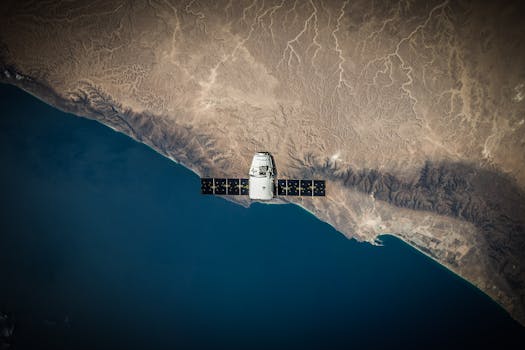MEO Satellites: Revolutionizing Global Connectivity with Medium Earth Orbit Technology

MEO Satellites: Revolutionizing Global Connectivity with Medium Earth Orbit Technology
MEO satellites, or Medium Earth Orbit satellites, are a type of satellite that operates in an orbit between 2,000 and 36,000 kilometers above the Earth’s surface. This unique position allows MEO satellites to provide a range of benefits and advantages over traditional satellite systems, including lower latency, higher bandwidth, and more efficient use of spectrum.
At the beginning of the MEO satellites era, the focus keyword MEO satellites has been a critical component of modern satellite technology, enabling global connectivity and facilitating communication between different regions of the world. With the increasing demand for high-speed data services and global connectivity, MEO satellites have become an essential part of the satellite industry.
How MEO Satellites Work
MEO satellites work by transmitting and receiving signals to and from Earth-based stations, using a range of frequencies and protocols to communicate with other satellites and ground-based systems. The medium earth orbit position of these satellites allows them to provide coverage over a wide area, making them ideal for applications such as navigation, communication, and remote sensing.
The use of MEO satellites has several advantages over traditional geostationary satellites, including lower latency and higher bandwidth. Because MEO satellites are closer to the Earth’s surface, they can provide faster transmission times and higher data rates, making them suitable for applications that require real-time communication and high-speed data transfer.
Applications of MEO Satellites
MEO satellites have a range of applications, including navigation, communication, and remote sensing. One of the most well-known applications of MEO satellites is the Global Positioning System (GPS), which uses a constellation of MEO satellites to provide location information and timing signals to GPS receivers on the ground.
In addition to navigation, MEO satellites are also used for communication and remote sensing applications. They can provide broadband internet access, voice and data communication services, and can be used for remote sensing applications such as weather forecasting, crop monitoring, and disaster response.
Future Developments and Trends
The use of MEO satellites is expected to continue growing in the coming years, driven by increasing demand for global connectivity and high-speed data services. Several companies, including SpaceX and OneWeb, are planning to launch constellations of MEO satellites to provide global broadband internet access and other communication services.
In conclusion, MEO satellites are a critical component of modern satellite technology, enabling global connectivity and facilitating communication between different regions of the world. With their unique position in medium earth orbit, these satellites offer a range of benefits and advantages over traditional satellite systems, and are expected to play an increasingly important role in the satellite industry in the coming years.
As research and development continue to advance, we can expect to see new and innovative applications of MEO satellites, from providing broadband internet access to remote and underserved communities, to facilitating communication and navigation for a range of industries and applications.
Benefits and Challenges of MEO Satellites
MEO satellites offer several benefits, including lower latency, higher bandwidth, and more efficient use of spectrum. However, they also present several challenges, including the need for more complex ground stations and the potential for interference with other satellite systems.
Despite these challenges, the use of MEO satellites is expected to continue growing, driven by increasing demand for global connectivity and high-speed data services. As the satellite industry continues to evolve, we can expect to see new and innovative applications of MEO satellites, from providing broadband internet access to remote and underserved communities, to facilitating communication and navigation for a range of industries and applications.
The MEO satellite industry is also expected to be driven by advancements in technology, including the development of new propulsion systems, power sources, and communication protocols. These advancements will enable MEO satellites to operate more efficiently and effectively, providing higher data rates and more reliable communication services.
In addition to these technological advancements, the MEO satellite industry is also expected to be driven by changes in government policies and regulations. As the demand for global connectivity and high-speed data services continues to grow, governments around the world are beginning to take notice of the importance of MEO satellites and the role they play in facilitating communication and navigation.
As a result, we can expect to see changes in government policies and regulations, aimed at promoting the development and use of MEO satellites. These changes may include the allocation of new spectrum for MEO satellite use, the establishment of new regulations for the operation of MEO satellites, and the provision of funding for research and development of new MEO satellite technologies.
Overall, the future of MEO satellites looks bright, with a range of benefits and advantages that make them an attractive option for a range of applications, from navigation and communication to remote sensing and broadband internet access. As the satellite industry continues to evolve, we can expect to see new and innovative applications of MEO satellites, driving growth and development in a range of industries and applications.
Conclusion
In conclusion, MEO satellites are a critical component of modern satellite technology, enabling global connectivity and facilitating communication between different regions of the world. With their unique position in medium earth orbit, these satellites offer a range of benefits and advantages over traditional satellite systems, and are expected to play an increasingly important role in the satellite industry in the coming years.
As research and development continue to advance, we can expect to see new and innovative applications of MEO satellites, from providing broadband internet access to remote and underserved communities, to facilitating communication and navigation for a range of industries and applications. The benefits and challenges of MEO satellites will continue to shape the satellite industry, driving growth and development in a range of areas.
The use of MEO satellites will also be driven by changes in government policies and regulations, aimed at promoting the development and use of MEO satellites. As the demand for global connectivity and high-speed data services continues to grow, we can expect to see new and innovative applications of MEO satellites, driving growth and development in a range of industries and applications.
The future of MEO satellites is exciting and full of possibilities, with a range of benefits and advantages that make them an attractive option for a range of applications. As the satellite industry continues to evolve, we can expect to see new and innovative applications of MEO satellites, driving growth and development in a range of areas.
In the end, MEO satellites will play a critical role in shaping the future of the satellite industry, enabling global connectivity and facilitating communication between different regions of the world. With their unique position in medium earth orbit, these satellites offer a range of benefits and advantages over traditional satellite systems, and are expected to play an increasingly important role in the satellite industry in the coming years.


